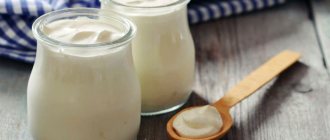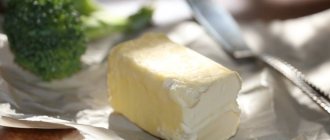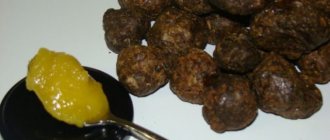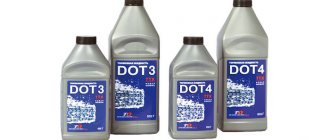In a refrigerator
The storage duration according to GOST and SanPiN is influenced by many factors:
- methods of primary processing of dairy raw materials,
- container,
- temperature regime,
- humidity,
- transportation conditions.
The humidity level should be 85-90%, and the optimal temperature should be in the range from 0 to +10 °C, depending on the type of product. Most products have short lead times due to the high risk of proliferation and exposure to various bacteria.
Pasteurized
This variety is most often found in stores. Pasteurization involves heating the liquid for a long time to 60 °C. As a result of heat treatment, pathogenic microorganisms die, while beneficial microflora and organoleptic properties are preserved.
Pasteurization at the enterprise allows you to increase the sales time to 2-3 weeks. Can be stored in vacuum packaging until the expiration date. If the seal has been broken, the container must be tightly closed and the contents consumed within 48 hours.
It is recommended to place packaged pasteurized milk on the third shelf or in the freshness zone.
UHT
Ultra-pasteurized is a milk product that has undergone heat treatment with short-term heating to 150°C and subsequent cooling to 5°C. In this case, some of the beneficial microelements are destroyed.
The shelf life of such a product is considered relatively long, it is set by the manufacturer and reaches six months, depending on the presence of various stabilizers, preservatives, and thickeners in the composition.
It can be safely placed on the refrigerator door or top shelves and stored until the date indicated on the package. It is not recommended to pour into another container and expose to sunlight.
Boiled
Boiled drinking milk retains its quality for 7 days.
Dishes that are planned to contain liquid must be pre-sterilized. Be sure to boil any product purchased from strangers. Remember that the usefulness of such a drink is significantly lower, since prolonged exposure to high temperatures destroys not only pathogens, but also protein, vitamins C and D, and makes phosphorus and calcium poorly absorbed.
Homemade
Village farm milk products are considered environmentally friendly and more valuable compared to factory-made ones.
Unfortunately, it quickly loses its freshness, so the maximum shelf life in a refrigerator is 48 hours.
It is recommended to pour into a clean jug or jar and close the lid.
Ghee
The origin of baked milk has Slavic roots. Preparation of the drink involves boiling and subsequent long, even simmering.
Does not sour longer than sterilized, can be stored in a refrigerator for up to 7-10 days.
Goat
Goat milk is less likely to cause skin and food reactions, which is why it is so loved by allergy sufferers. The unique composition is rich in important microelements and vitamins.
A fresh product that has not undergone heat treatment will last in the refrigerator for about 3 days if placed in a sterile and airtight container.
Once opened, a store-bought product will retain its beneficial properties for a week. Repeated boiling is prohibited.
Lactose-free
Lactose-free is produced using special technologies for removing or hydrolyzing lactose. Ideal for diabetics and people with lactose intolerance.
At temperatures from 0 to +6°C, opened packaging is stored for 3-4 days, closed – no more than 30 days.
Concentrated
Concentrated is the result of partial dehydration and sterilization (preservation) of raw milk. Used in cooking for making soups, sauces, desserts and baked goods. Ideal for hiking and living in the wild.
The products are easy to store, the recommended temperature varies up to +10 – 20 °C depending on the container, the storage period is 3 years.
Condensed
The shelf life of condensed milk is the same as that of concentrated products (2-3 years).
Sukhoi
Powdered milk is a soluble powder obtained after condensation and drying of raw materials. It is used for preparing various dishes, including food in kindergartens.
Low fat preserves its taste for 3 years and whole dry for 10 months. Store the diluted solution for no more than 72 hours.
Vegetable
Plant-based milk products are prepared from nuts, plant seeds, and cereals. The most famous varieties are coconut, almond, sesame, poppy, pumpkin, cedar, oat, rice, and soy milk.
Keep in the refrigerator for no more than 3 days.
Chest
According to the website of the Association of Natural Feeding Consultants (AKEB), fresh breast milk for a baby is stored from 72 hours to 8 days.
The longer it is in the refrigerator, the less vitamins and antioxidants remain in it. It is recommended to pour into a tightly closed bottle to prevent the absorption of foreign odors and to note the date and time of pumping.
Differences for raw and boiled products
The main difference between boiling and raw storage is the shelf life.
It should be borne in mind that fresh milk purchased from private owners or from a farm may present an unexpected surprise. That is, it loses its freshness (go sour) literally within 1 – 2 hours.
After all, when purchasing raw dairy products, it is impossible to determine how much time has passed since milking . The negative impact can be caused by long transportation of milk and poor quality treatment of the cow's udder before milking.
Therefore, fresh milk must be boiled as soon as possible. Even when placed in a refrigerator, the shelf life directly depends on the power of the unit.
Eg:
- at a temperature of 6-8 degrees, milk will not spoil within 18 hours;
- if the temperature in the chamber is 5-6° - about 24 hours;
- at 3 – 4°C for up to one and a half days;
- If the temperature is constant at 1 degree, then the milk will not turn sour for 2 days.
The boiling process and the use of clean dishes, ensuring the destruction of pathogenic bacteria, can extend the shelf life to three or even four days.
In the freezer
If you want to keep your drink fresh longer, freezing will help. You can store it in the freezer in:
- Vacuum bags.
- Small plastic jars.
- Forms for ice (later used to add to coffee).
Initially, you should pour a little liquid from the container in which you plan to freeze the product. This is necessary because the contents expand and can damage the plastic. For breastfeeding, you need to prepare special containers or bags with a zipper (chicco, medela, Tommee Tippee).
Frozen storage time is 4 months.
Do not heat in a microwave oven or re-freeze. To defrost, place on refrigerator shelf until thawed.
How to increase shelf life?
The shelf life of milk can be increased in several ways. Among them:
Fast cooling . Immediately after milking, place the milk in cold water, cover with ice, then place in the refrigerator. The faster the process, the longer the cow's drink will remain fresh.- Pasteurization . The milk is heated at a temperature of 80–85 degrees, kept for 2–4 minutes and quickly cooled. In this way, you can extend the shelf life up to a week and preserve some of the vitamins and minerals.
- Boiling . The period of freshness of the drink increases to 2 weeks, but almost all useful components are lost.
- Freezing . The product will last up to six months.
It is not advisable to specifically increase the shelf life of milk. If possible, it is better to purchase a portion of fresh milk, which is not a big problem today. Details are here.
At room temperature
At home, at room temperature, you should not leave it open for longer than 6-10 hours, as this will lead to gradual souring.
Outside the refrigerator should be placed in a dark, cool place away from the radiator and other heating elements.
Condensed, concentrated and powdered milk can be stored at +20°C for several months.
Can it be frozen?
One way to preserve milk longer is to freeze it. It should be borne in mind that in this case the product loses some useful substances. However, freezing pays off if you need to store milk for future use. In this form, the drink can be stored for up to two months.
Milk can be frozen in bags, plastic bottles, and ice cube trays. It is recommended to pour up to 3/4 of the volume into clean bottles, since liquid increases when frozen.
When it's time to defrost, you need to do it gradually . First, transfer the milk from the freezer to the refrigerator for a day or night. A defrosted drink is stored in the same way as a regular pasteurized one.
Re-freezing the product is not recommended. In this case, the milk completely loses its unique taste, color and smell.
This video will show you how to freeze milk:
Depending on the container
Plastic bag
Soft packaging (fin-pack, berta-pack) has a low cost and is usually used for pasteurized dairy products (Pestravka, Piskarevskoe). This is a film made of high-strength polyethylene, dense and grease-resistant, protecting from exposure to sunlight.
The shelf life is 3 weeks.
Plastic bottle
The product in a plastic bottle (Kubanskaya Burenka, Selo Zelenoe, Vkusnoteevo, Little House in the Village, Vesyliy Milkman, Prostokvashino) has a short shelf life (up to 3 weeks) due to lower tightness compared to a tetra bag and the risk of exposure to sunlight.
Can
The tin can (Shadrinskoe) is practical.
Allows canned contents to be stored for several years.
May give a slight metallic taste.
Tetrapack
Tetrapak (Bezhin Lug, Parmalat, Agusha, Frutonyanya, Semenishna, Yasny Lug) allows you to preserve the taste and is easy to use. Typically, UHT milk is produced in a box, requiring aseptic filling, which is what this type of material provides.
The product is good for an average of six months.
Glass
Glass was actively used during the Soviet era, but is now rarely found: mainly for premium and children's products (EtoLeto, Rogachev, Mozhaiskoye). It is easy to damage, and when exposed to sunlight, vitamin C is destroyed very quickly. It preserves the taste of dairy products best of all.
In such packaging, the contents have a short shelf life of 36 hours.
Types of milk
- Pasteurized milk is considered the healthiest. Microorganisms in the product remain viable due to one-time heating for 30-60 minutes.
- UHT milk is heated to high temperatures for a few seconds and immediately cooled.
With this treatment, the bacteria are killed, but the vitamins are preserved.
- Sterilized milk. Due to the use of very high temperatures during processing, it loses almost all beneficial properties. But this type of milk has a long shelf life.
- Raw milk. On the one hand, the product straight from a cow or goat contains all the useful substances. On the other hand, consuming it without prior boiling, especially for children, is highly discouraged.
- Goat milk. The calcium content in it is higher than in cow milk. But there is also much more fat - 10 g per 1 glass.
- Soy milk is made from soybeans and contains large amounts of soy protein.
Soy milk contains almost no calcium, but manufacturers solve this problem by artificially enriching the product with it.
- Baked milk is processed in a gentle way, thanks to which it retains its beneficial properties.
- Powdered milk. Normalized cow's milk powder retains most vitamins and minerals.
- Coconut milk is made from coconut pulp and is 2/3 water.
Condensed concentrated milk has almost all the beneficial properties of milk. Moderate consumption of the product is recommended; high sugar content can negatively affect health.
Determining the delay
In order not to purchase expired goods in a supermarket, market or from hand, adhere to the following rules:
- There should be no unpleasant or strange odor (if purchased steamed or unpasteurized).
- Choose the freshest product with a recent production date (Promotions most often sell expired products).
- When buying at the market, ask the merchant for certificates, look at the sanitary conditions of the point.
- Consumer packaging must not be deformed or swollen.
- Between whole and normalized, it is preferable to choose whole selected.
Marking according to GOST
Marking on consumer packaging is applied in accordance with GOST R 51074. This document lists the information that the manufacturer applies to the packaging. Among other things, the expiration date is also indicated.
The same GOST states that if a product must be kept under certain temperature conditions, then storage conditions are also applied to the consumer packaging. Accordingly, the package (box, bottle, etc.) of milk indicates at what temperature it must be kept before and after opening.
Security measures
It happens that the expiration date has already expired, but the milk still has normal color and taste. In this case, it can be used even if the period stated by the manufacturer expired 1-2 days ago.
If the milk has acquired a bitter taste, then there is only one way for it - in the trash. This product should not be consumed to avoid serious food poisoning.
When buying milk at the market, you need to pay attention to the smell of the product. A strange or unpleasant smell indicates that the milk is not fresh.
In stores, employees must strictly observe the expiration dates of all products. They should, but they don’t always comply.
In addition, this trick is common in retail outlets - a fresh product is placed further away from the buyer, and an almost expired product, on the contrary, is placed closer.
So, if you bought expired milk, you have every right to return it.
It is in the buyer’s interest to study the information on the packaging, especially the expiration date.
Watch also the video about the expiration dates of milk:
Storing breast milk
Breast milk is an indispensable product of baby food, so almost every new mother is forced to express breast milk.
In order not to harm the baby’s health, he must be fed only fresh foods, so all breastfeeding mothers need to know how to store breast milk.
You can find out everything about storing breast milk HERE
Sources
- https://zakonpotr.ru/srok-godnosti/hraneniya-moloka.html
- https://pravo.guru/zzp/torgovlya-i-tovary/sroki-godnosti-i-hraneniya/pishhevoj-produktsii/molochnyh/moloka.html
- https://profhranenie.ru/srok-godnosti-moloka
- https://msk-holod.ru/info/articles/khranenie-molochnoy-produktsii/
- https://rem.ninja/kuhnya/hranenie/naturalnogo-i-pasterizovannogo-moloka.html
- https://hraneniegid.ru/produkty/moloko/skolko-sostavlyaet-srok-hraneniya-pasterizovannogo-moloka-po-pravilam.html
- https://hozjajkainfo.ru/kak-xranit-moloko/
- https://pravilauborki.ru/kak-hranit/srok-godnosti-moloka.html
Sterilization of milk
This method of processing fresh milk consists of briefly heating it to a temperature of 115-145 degrees. This heat treatment kills all microorganisms – both pathogenic and beneficial. It also destroys some vitamins, enzymes and other valuable substances. The milk turns out to be sterile and does not provide any benefit to the body. Sterilized milk in sealed packaging can be stored for up to 6 months.










